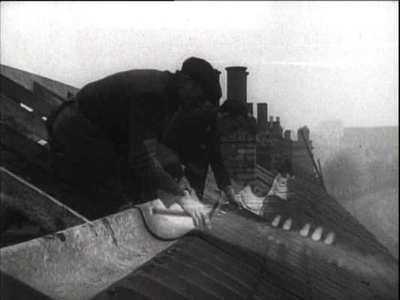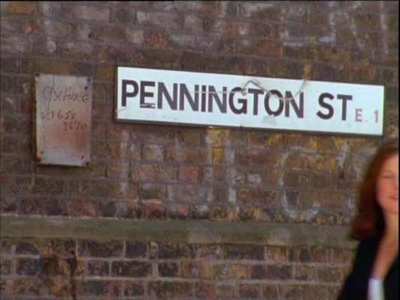Review of Humphrey Jennings Collection, The
Introduction
This collection should prove irresistible for those with an interest in social history and wartime Britain. It`s also a real treat for those with an interest in documentary filmmaking and, in particular, in Jennings`s unique spin-off from Grierson`s distinctive wartime GPO film unit.
Humphrey Jennings was an interesting character in his own right, coming from a background steeped in the arts (painter, poet, academic social analyst and writer). Joining the Crown film unit must have been as strange for Jennings as it was for the earnest but conservative filmmakers already employed, and by all accounts the relationship was never an easy one. But, as this DVD illustrates so perfectly, the results of his labours were really quite magnificent.
The DVD contains three of Jennings most well known wartime works as well as an informative Channel 4 documentary about the man and his work.
First up is a 20-minute slice of wartime life in Britain called `Listen to Britain` (1942). This was actually co-directed by Jennings alongside Stewart McAllister, and is unique in that it contains no narration at all. Jennings concept was to capture 24 hours in the life of a nation at war, though this is not the kind of fly on the wall stuff we`re used to today. This is a carefully considered and composed piece that, whilst certainly containing much that reflects everyday life in Britain (with no actors and plenty of `natural action`), the juxtaposition of shots as well as the careful composition of shots betrays some forward thinking. But its power is undeniable. Whilst much propaganda of the period, with terribly earnest voice-overs and comically contrived action, looks almost laughable to our world-weary eyes today, this programme is still frighteningly moving. London decimation is cut next to rural village life; factory workers are seen just prior to shots of flying Spitfires. Classical music is intercut with the sound of steelworks and the low engine hum of the Lancaster bomber. We see a Britain still able to enjoy tea dances and Flanagan and Allen whilst also having the strength to stand up to the pervading evil of Nazism.
Even today, this 20 minute piece will have you jingoistically puffing your chest with pride - and it must have been very powerful in its day.
Nearly every frame has the considered composition of a painter and, for the first time, the fairly straightforward work of the GPO film unit (actually renamed the Crown film-unit during the war) was replaced with what could really be considered to be `artistic` filmmaking.
Also included is the feature length `I was a Fireman` (1943), better known to many as `Fires were Started` (which was the name given to its VHS release). This also takes a 24-hour period supposedly during the Blitz. Using real firemen (rather than actors), this exciting `drama` perfectly captures the unique combination of terror, drama, bravery and camaraderie that was the life of firemen in London during this turbulent time. It`s still a powerful movie with some surprisingly good performances from its amateur cast. It`s notable that the cast (when interviewed later) all seem to concur that Jennings was an incredible individual, driven by his work and the work that his films were to do in further raising spirits during this difficult time.
The final documentary contained on the set has dated less well than the first two. `Diary for Timothy` (1945) suffers from period narration (Michael Redgrave) reading a script by E.M. Forster, which, to today`s cynical ears sounds slightly patronizing. Set in 1945, when Britain was exhausted and wearied by a relentless war, the movie describes the state of the world to a newborn baby - blissfully unaware of the brave efforts of his fellow-countrymen to ensure that life would be better for babies like himself. Despite the dated commentary, it`s still a moving piece. The film (like `Listen to Britain`) really features the home front, and betrays Jennings own belief that the arts are a major ingredient in retaining the countries morale during these dark years. There`s another concert with the manly-looking classical pianist Myra Hess (also featured in the previous movie), as well as John Gielgud performing `Hamlet`.
There`s some live news from the BBC (both good and bad in equal measure) and no firm hint of V-day on the horizon, despite the fact that there was much optimism in the air at the time of its making. (Maybe Jennings (and his masters at the war office) were nervous about the nation becoming too complacent). There is, once again, a wealth of wonderfully shot period footage that will give anyone with a thirst for historic detail great insight into the sight and sounds of wartime Britain.
Finally, there is a really informative documentary on Jennings, directed by Kevin Maconald for Channel 4, called `Humphrey Jennings: the man who listened to Britain`. The title reference seems to suggest that Jennings interest and participation in the social experiment of `Mass observation` (a slightly patronising but well-meaning academic adventure where `real working class people` were observed by Jennings and his cohorts, with their words and actions recorded for posterity) must have shaped his approach to filmmaking. There are a wealth of interviews with those who knew and worked with Jennings, as well as healthy doses of comment from his daughter too. There are lots of other examples of his fine work which I hope will also see a release in the not too distant future, such as `Spare Time`, `London can take it!`, and `The Silent Village`.

Video
These prints were obtained by the BFI in conjunction with the Imperial War Museum and they`re in pretty good shape, though far from perfect. There are many scratches and sparkles, and whilst there has been a careful digital transfer of these precious prints, there has been little in the way of restoration. However, the scratches and blips are occasional only and don`t spoil the overall enjoyment and interest in the films.
They all come in their original ratio (4:3) too, which is hardly surprising!

Audio
Very robust period mono which works fine, and on surround comes directly at you from the centre speakers.

Features
With 184 minutes included, it would be surly to complain about lack of extras. Besides, I guess it could be argued that the very fine Jennings documentary is an extra in which case there is no case to be answered at all!

Conclusion
Described as `the cinematic poet laureate of Britain at war`, Humphrey Jennings contribution to British film and documentary is considerable. Although John Grierson and the GPO film unit had certainly made documentary respectable before the war, it was Jennings who brought an artistic sensitivity to reality filmmaking and really moved the `art` of film propaganda up a bar.
The three films contained on this release provide a very worthwhile addition to any serious film-fan`s library. They contain fine historic examples of good filmmaking, with carefully composed shots carefully juxtaposed in the edit to be as emotively powerful as possible.
They`re also really interesting historic documents giving excellent insight into what everyday life was like in Britain during the war years.
As an added bonus, there is a very thorough documentary overview on Jennings and his work that really makes this a very satisfying package indeed.
I waded in from the top, saving the documentary until the end, though I would advise watching the documentary first as it contains much of interest and relevance to further your appreciation of the films. (I ended up viewing all three films a second time after the documentary as a consequence).
Thoroughly recommended for those with an interest in social history of this period and/or the history of documentary style public-service filmmaking.
Your Opinions and Comments
Be the first to post a comment!